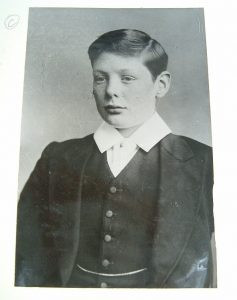The tale of Winston Churchill’s life being dramatically saved by Alexander Fleming, or even Fleming’s father, is a captivating story that has circulated widely online for years. It’s a charming narrative, but like many historical anecdotes that sound too good to be true, this one firmly falls into the realm of fiction. Let’s delve into the origins of this myth and examine the facts behind the supposed Churchill-Fleming connection.
The Genesis of a Medical Myth: Coronet Magazine
The likely starting point for this enduring myth can be traced back to a December 1944 issue of Coronet magazine. An article titled “Dr. Lifesaver,” penned by Arthur Gladstone Keeney, a newsman with wartime service, presented a heartwarming, albeit fabricated, account. Published shortly after Churchill’s bout with pneumonia, Keeney’s story seems to be the seed from which the Churchill-Fleming myth sprouted.
 Winston Churchill at Harrow
Winston Churchill at Harrow
In Keeney’s fictionalized version, young Winston Churchill is saved from drowning in a Scottish lake by a heroic farm boy named Alex. Years later, a grateful Churchill supposedly sponsors Alex’s medical education. This Alex, graduating with honors and making a groundbreaking discovery about mold inhibiting bacteria in 1928, becomes none other than Alexander Fleming. The story culminates in 1943, with Fleming’s penicillin miraculously flown to the Near East to cure a seriously ill Churchill, thus completing the circle of life-saving events.
Debunking the “Dr. Lifesaver” Narrative: The Truth About Churchill’s Pneumonia
However, historical records and expert analysis paint a very different picture. Dr. John Mather points out a critical flaw in the myth: Churchill’s severe pneumonia was not treated with penicillin. Instead, he was successfully treated with sulfadiazine, commercially known as ‘M&B,’ a drug developed by May and Baker Pharmaceuticals. The effectiveness of M&B strongly suggests a bacterial infection, for which sulfadiazine was an appropriate treatment at the time.
Furthermore, Kay Halle’s book, Irrepressible Churchill, offers an amusing anecdote highlighting Churchill’s actual medication. She notes Churchill’s playful references to his doctors, Lord Moran and Dr. Bedford, as “M&B.” Churchill even quipped to his nurse about needing more than just “M and B” to live on, especially when he discovered it could be taken with whisky or brandy. Crucially, there’s no documented evidence of penicillin being used during Churchill’s wartime pneumonia. While penicillin and other antibiotics likely became part of his treatment in later life for other infections, it was not the “miracle cure” in the pneumonia episode as the myth suggests.
 2025 International Churchill Conference Washington, DC
2025 International Churchill Conference Washington, DC
Adding another layer of factual contradiction, Sir Martin Gilbert, Churchill’s official biographer, highlights the age disparity. Alexander Fleming was actually seven years younger than Churchill. The timeline of the myth, placing a teenage Fleming saving a young adult Churchill in Scotland, simply doesn’t align with their birthdates. Moreover, there’s no historical record of Churchill ever nearly drowning in Scotland, nor any indication of Lord Randolph Churchill sponsoring Fleming’s education. Lord Moran’s diaries, a detailed account of Churchill’s health, mention “M&B” but remain silent on penicillin or any dramatic airlift of the drug to the Near East.
The Real, Less Mythical Churchill-Fleming Encounter
While the dramatic life-saving narrative is unfounded, Winston Churchill and Alexander Fleming did cross paths. Records show that Churchill consulted Sir Alexander Fleming in June 1946 regarding a staphylococcal infection that had proven resistant to penicillin. This consultation, documented in Lord Moran’s diaries, reveals a real, albeit less sensational, connection between the two figures – a meeting of minds in the face of a medical challenge, rather than a tale of life-debt and miraculous cures.
In conclusion, the story of Alexander Fleming saving Winston Churchill’s life is a captivating myth, likely born from a magazine fiction piece. While charming, it crumbles under historical scrutiny. Churchill’s pneumonia was treated with sulfadiazine, not penicillin, and the timeline and circumstances of the supposed life-saving events are demonstrably false. The real connection between Churchill and Fleming is far less dramatic but rooted in actual historical events – a consultation about a medical issue years after the pneumonia incident. The myth, while persistent, serves as a reminder to always verify even the most appealing historical narratives, ensuring that fact prevails over fiction, even when the fiction is a good story.
